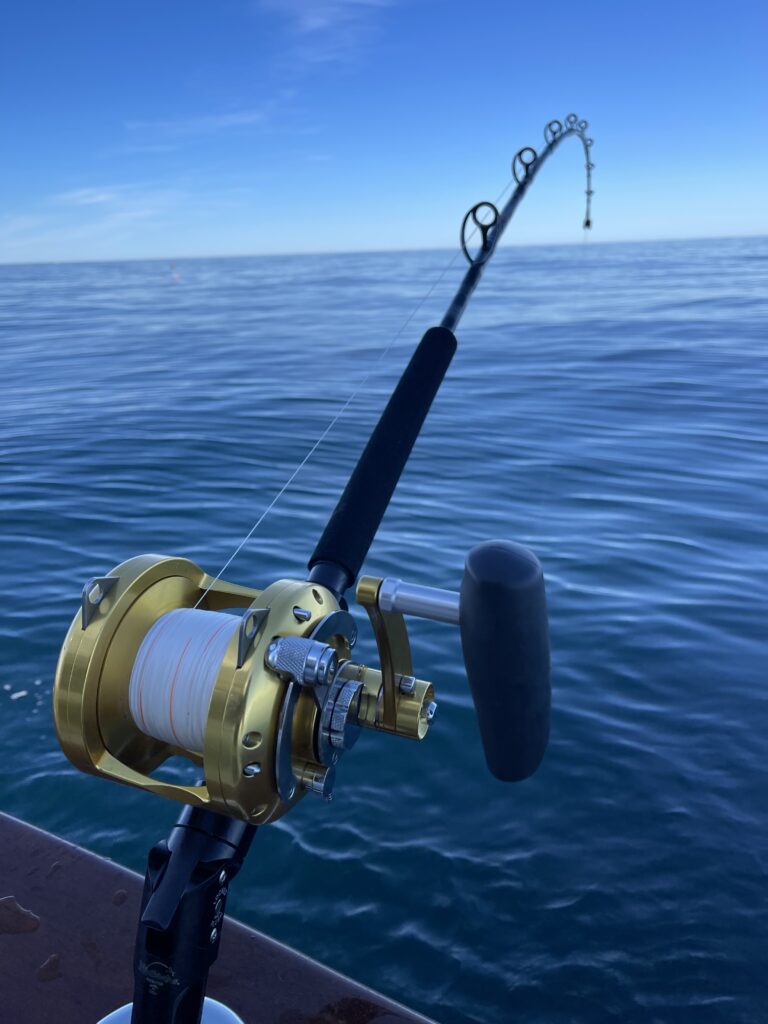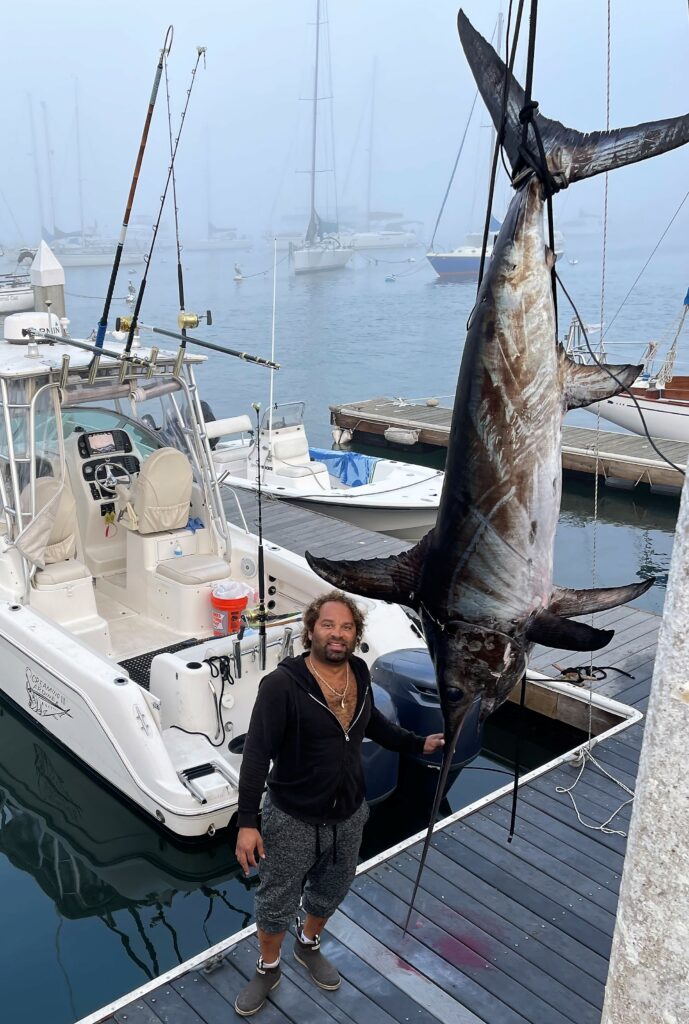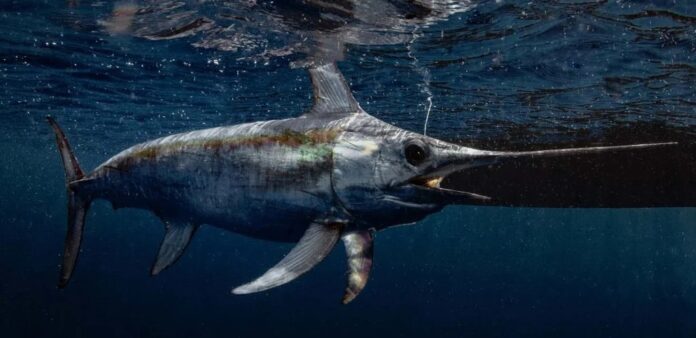BY LAMAR “SO SALTY” LEE
Special to Western Outdoor News
1 PREPARATION
Swordfishing is something that takes time and patience. Patience is key. You want to make sure you have the right gear from start to finish. First is the bait. You can use several different kinds of bait like squid, eels, fish bellies and even ar- tificial baits. Personally, I have had the most success with squid.
I prefer to rig them with a glow-in-the- dark skirt. Then your leader and lights. You want to make sure you use a wind on leader that has your weight loop on it. I found that two small lights on the leader and one big light attached to my weight has produced great results. You can use a weight from 6 to 10 pounds depending on the current.
Rod and reel. I’ve used several rods and I like the Phenix Megal- adon and the Phenix Axis rods the best — great action in the tip so you can see the bite, and the nec- essary backbone to bring the mon- ster up from the deep.
As for reels, you can go either electric or conventional. For the electric reel, I use the Daiwa Seaborg and I’ve fallen in love with Avet 50 Wide 3-Speed for my conventional setup. Any big reel that holds a lot of line will work.
The Avet 3-Speed feature enables a super-fast retrieve, which is key to get tight on your sword as it rushes to the surface. Make sure to have at least 2,000 feet but if the reel holds more, then add it. Make sure to have your flying gaff and back- up gaff ready as well as a tail rope ready to go. Have a plan, but we all know things can change quickly once you stick one of these fish.

2 LOCATION
The best places in SoCal to catch a swordfish are your local banks and canyons. You can also follow the temp breaks and try to figure out the water temps that they like. Also, try to find bait lo- cated deep before you drop down.
Try to find the feed layer and start drifting in those areas. The depth you want to fish is generally be- tween 700 and 1,300 feet down. Most fish are caught between these depths but you can also find them basking on the surface. They come to the surface only to digest their food, so it is hard to bait them on the surface.
3 BITE AND THE FIGHT
There are two ways we fish for swordfish: The first is a buoy setup and the second is with a down rod. With the buoy setup, you pick the depth and attach a buoy loop to your main line. I put one at 800 feet and one at 1,000 feet. You can use wax line, or if you have hollow Spectra, you can splice it in. Some people use a Bimini twist to add a buoy loop.
The weight will stand the buoy straight up and when you get a bite the buoy will fall flat on the water or just disappear. Typically, when you hook a swordfish they swim up to the surface. The buoy will lay flat because the fish is swimming up with the weight.
The second way to fish is with a down rod, aka “tip rod.” There is no buoy to indicate a bite. You just have to watch the tip. The fish will typically come and whack the bait. It’s a quick “tap-tap” you see in the tip of the rod. If you are not watching carefully, you may miss the opportunity to set the hook. If your rod goes slack, you know the fish is hooked and swimming the weight up to the surface.
When you see a bite and the fish doesn’t commit, you can drop it down 50 feet and see if the fish will chase the bait. Give it some action by dropping it down and winding it back up to entice the fish to bite. Once the fish is hooked, wind like crazy. That’s where the 3-speed is handy.
They can swim up 1,000 feet extremely quickly and you don’t want slack in your line. Once the fish is to the surface and you get the weight off the true fight is on. I recommend having a fighting belt or a harness so you can fight the fish comfortably. It can sometimes take hours to tire one of these monsters out. And you don’t want them to have too much energy when you gaff them.
4 GAFFING THE FISH
Once you get the fish to a point when it is tired, you can gaff it. Make sure to have your flying gaff ready along with a few backup gaffs and a tail rope. You don’t want to be scrambling for something when you get the opportunity to land the fish. Have your ropes secured to a cleat in case the fish takes off.
Make sure to watch out for the bill when you stick them because they can be deadly. It’s best to gaff it in the head and then the tail. Then pin it to the side of the boat and tail wrap it. Most importantly, make sure the fish is dead before bringing it on the boat.
5 PROCESSING YOUR CATCH
Swordfish is absolutely amazing to eat so you want to take good care of your meat. Once the fish hits the deck and you have all the pictures you need, if you’re not going to weigh it, get it gutted and on ice ASAP. It is best to ice these fish for 24 to 48 hours before fileting it. Before cutting the fish, you need to scrub the skin with a brush and hose it down.
Once it’s scrubbed down and you start filleting, you may see some parasites in the meat. Just cut them out and a cut little bit of the meat around them. Filet the fish and get it vacuum sealed. You can save the tail and the bill. It takes a while for them to dry out, but you will be happy you kept them.
Swordfishing is becoming increasingly more popular along our coast. Hopefully these few tips will help you prepare and have success on the water. Remember to always have fun, stay safe, and stay salty.
Tight lines!




